Blackburn Buccaneer - History
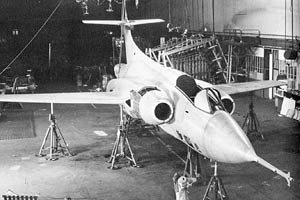
NA.39 XK486 being built; Blackburn Aircraft Ltd.
July 1953 saw the issuing of Naval Staff Requirement NA.39 (later M.148T), calling for a carrier-borne strike aircraft with a large range capable of carrying a nuclear weapon under enemy radar cover and striking enemy shipping or ports. Blackburn Aircraft won the tender to produce their design (known within Blackburns as the B.103). The NA.39 was an advanced aircraft for its time and the secrecy surrounding the new construction and design techniques being used meant that the project remained top-secret until February 1957. Until then, the great secrecy surrounding the project led to the aircraft being called merely 'BNA' or 'BANA' (for Blackburn Naval Aircraft or Blackburn Advanced Naval Aircraft) in many documents. Inevitably this led to the design being called the 'Banana Jet' by some workers, a name that would persist throughout the jet's service career.
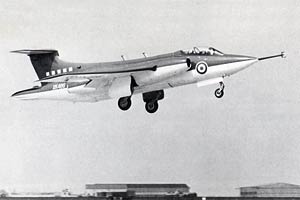
NA.39 XK486 taking off for her first flight; Blackburn Aircraft Ltd.
While some of Blackburn's initial designs had the aircraft with a bulbous nose (with side-by-side seating for the two crew), high wing and engines by the wing roots, the design soon settled on the familiar area-ruled Buccaneer shape seen here (America's Grumman would later settle on a design very similar to Blackburn's early B.103 design for their A-6 Intruder, an aircraft designed to much the same specification as the Buccaneer). Area ruling was an idea to improve stability and to reduce drag at higher speeds by changing the fuselage shape to counteract area increases elsewhere - i.e. make the fuselage thinner at the wing roots but bulged out elsewhere. Some have said the reason for 'Banana Jet' was that the area ruling and the high tailplane made the aircraft look vaguely banana-shaped! Initial design was complete in July 1954 and the development contract was awarded a year later. As with the Lightning project, 20 pre-production aircraft were ordered to speed development on every aspect of the aircraft.
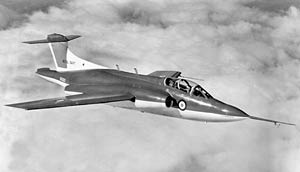
NA.39 XK490; Charles E Brown
Some of the advanced features included the area-ruling, extra-strong wings and spars (milled from large steel forgings) and boundary layer control. This was the redirection of part of the engine bleed air through slits at the front edges of the wings, leading to the wings producing much more lift for their size than would be normal. This in turn enabled lower approach speeds, higher weapon loads and of course kept the aircraft's size within carrier limits (in combination with folding wings and nose and the split rear fuselage airbrake). Another Buccaneer innovation was the miniature detonating cord (MDC) in the canopy which would fragment the canopy in the event ejection was necessary, making ejection through the canopy much safer (since used on the Harrier, Hawk, Tornado, etc). Initially designed to help underwater ejection it was soon realised how useful it could be out of the water as well! The first prototype, XK486, flew on the 30th of April 1958 and performed at Farnborough in August of that year.
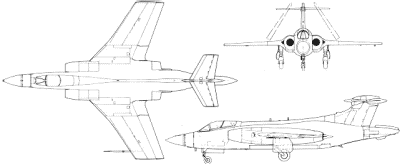
NA.39/Buccaneer S.1 plans; Roy Boot
Externally the obvious differences between this early prototype and later Buccaneers were the long nose probe (but short nose) and aerodynamically simple tailplane junction, along with the small intakes. Production of the development batch continued with each aircraft looking subtly different - introducing different airbrake, tailplane and nose designs until an acceptable standard was reached. Unfortunately development was marred by a number of incidents, most serious of which were the loss of three aircraft - starting with XK490, the 5th NA.39, which crashed in October 1959 when a US test pilot attempted to fly the aircraft in a configuration as yet untested and for which he had not been cleared - it stalled at 10,000 ft and with not enough height to recover, both crew were killed when they ejected while inverted shortly before the aircraft impacted the ground. The first prototype was lost in October 1960 when the pilot sensed that the aircraft was rolling without his input and initiated ejection. In fact the artificial horizon had failed and, flying in cloud, the pilot was unable to see the real horizon. Both crew ejected successfully. Next loss was of XK529 - the 13th production aircraft, or aircraft "12A" (superstition plays its part in aircraft manufacture!) - crashed in Lyme Bay during carrier trials on 31st August 1961, killing the crew. It had over-rotated during a catapult launch, stalled and fallen into the sea.
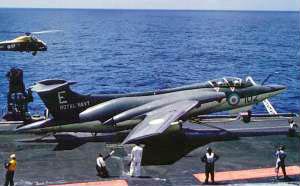
S.1 XN971 of 800 NAS launching from HMS Eagle, 1964
Carrier trials had begun back in January 1960, with the first landing (on HMS Victorious) being on the 19th. In August of that year the Navy officially named the new aircraft the Buccaneer S.Mk.1. Interest in the new aircraft was strong in Germany but a combination of the usual British government incompetence and the Germans wishing to standardise on a single aircraft type for most roles (the F-104 as it turned out) meant that the Buccaneer lost its chance to serve in the Marineflieger. Meanwhile, 700Z squadron was formed on the 7th of March 1961 at RNAS Lossiemouth (thus beginning the station's 33 year association with the Bucc), and was a trials squadron using the now standard Navy technique of having an initial squadron dedicated to getting new aircraft into service as smoothly and quickly as possible. The retractable refuelling probe proved problematic so instead a fixed probe was introduced, thus marring the Buccaneer's otherwise clean lines (as would RWR bullets on the wing leading edges and tailplane junction). By November 1961 700Z's Buccaneers were being painted overall anti-flash white, a sign that they were now getting to grips with the nuclear strike role. One of the Buccaneer's many unique features was a revolving bomb bay - so weapons could be carried internally thus causing no drag penalty yet quickly dropped when required, without opening up huge doors into the airstream. Designed this way more for a smooth and economical flight to the target than for stealth, it was no doubt an unexpected bonus that this method of opening up a bay did not lead to a large increase in the aircraft's radar signature.
The first operational Buccaneer squadron was to be 801 NAS. Receiving their first S.1s in July 1962, they were first embarked for a short cruise in February 1963. 700Z, its work done, had been disbanded in January and its aircraft assigned to 809 NAS, the 'headquarters' (basically aircrew training) squadron. 801 re-embarked on HMS Victorious for a Far East cruise in August and during the carrier's return home in January 1964, the situation in various East African countries called for the carrier to prolong its patrol in this area, with 801 on standby to provide backup for ground forces. In the event no action was seen. The second operational squadron was 800 NAS, sailing on HMS Eagle in December 1964. While the Buccaneer had now practically replaced the Scimitar in the strike role, 801's experience in the hot climate of the Far East had shown that the Mk.1 Buccaneer's Gyron Junior engines were insufficiently powerful to get a fully-loaded Buccaneer off the deck safely, so Scimitars went along on HMS Eagle to provide a refuelling service. Now the Buccaneer S.1s could take-off with a lighter fuel load leaving more capacity for weapons carriage, and could be refuelled immediately after take-off by the Scimitars.
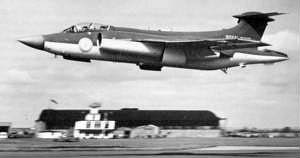
First flight of the first S.2 conversion, XK526 on 17th May 1963; Blackburn Aircraft Ltd.
Lack of power wasn't the Mk.1's only problem - the inlet guide vanes for the engines were problematic, and sudden banging noises and power loss - or engine failures - when they malfunctioned were an all too common occurrence. To sort out the problem of the underpowered Mk.1 in a more permanent manner, development had been going on to re-engine the Buccaneer with a more powerful and fuel-efficient powerplant. One problem was that the main spar actually included ringed sections that went around the jetpipes so to avoid a very expensive redesign, an engine of identical or smaller jetpipe diameter was required. Eventually Rolls Royce's Spey was chosen, which with careful positioning would fit into the spar rings, though a major redesign of the center fuselage and intakes was still required. While discussions on the Mk.2 Buccaneer had begun in late 1959, conversion work did not start until January 1962, being completed in May 1963. The delay was put to good use; many components of the Mk.1 were replaced by more modern and more reliable versions and a new electrical generating system was also included, along with stronger undercarriage (in anticipation of the higher loads the Mk.2s would be carrying). Later an improved radar and attack system would be fitted.
The improved Mk.2 Buccaneer was offered to the South Africans as an ideal aircraft for protecting the sea lanes around the Cape and soon 16 Buccaneers were ordered. These were S.50s - similar to the S.2 but with the wing-folding mechanism no longer powered and with the addition of two rocket engines in the rear fuselage to assist take-off at hot and high airfields. One of the first batch of 8 was lost on the delivery flight leaving only 15 to enter service with 24 squadron. The British government soon did an about-face and would not allow any more to be procured, however. Meanwhile service in the RN was going well - HMS Eagle relieved HMS Ark Royal just in time for the Rhodesian declaration of independence in March 1966, so aircraft from 800 NAS on HMS Eagle took part in the Beira Patrol, the oil blockade of Rhodesia, returning to Lossiemouth in September. While the new S.2 had first flown in May 1963, carrier trials only began in April 1965 (including cross-deck trials on the USS Lexington later in the year). At the conclusion of trials in American waters, one Buccaneer made the record books by flying from Goose Bay, Canada straight to its base at Lossiemouth in Scotland unrefuelled. Taking four hours and 16 minutes to cover the 1,950 mile trip, it was the first Fleet Air Arm aircraft to make the Atlantic crossing in one hop. Introduction of the S.2 into service went relatively smoothly compared with the S.1, and the higher-powered aircraft rapidly became very popular.
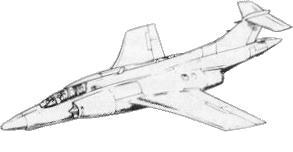
Blackburn P.150 - a supersonic Buccaneer that could have fulfilled the TSR2 requirement; Roy Boot
Around this time the TSR2 project to specification GOR.339 (an attack aircraft that could have been described as a 'Super-Buccaneer') was coming under attack from many sides, and the Admiralty played their part in its downfall by pushing for the Buccaneer as a near-ideal aircraft to satisfy the requirement, yet costing far less than the increasingly expensive TSR2. Strangely, Blackburn did not take full advantage of this. In any case, the RAF were extremely hostile to the idea of operating an aircraft designed for the Navy, and it found no favour with them at all. While Blackburn produced a brochure for the Ministry of Supply on the Buccaneer, they did not produce designs for a truly upgraded Buccaneer until after the TSR2 had already been cancelled. Among designs that included a fighter variant (the P.140) and a more versatile strike variant (the P.145), the P.150 stood out as the most advanced. This would have been a supersonic (mach 1.8) Buccaneer with extended fuselage and new wings for the long-range strike role (i.e. the TSR2's role, later to be fulfilled by the MRCA, or Tornado). However, this never left the drawing board.
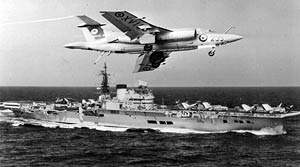
S.2 XV155 makes a dirty pass by HMS Victorious in 1966; from Patrick J. Burke's collection
Back to 1966, though, and disaster for the navy - the new Labour government's defence review cancelled the navy's planned new carrier (CVA-01; desperately needed because the small size of the existing carriers led to difficulties in operating large and heavy aircraft such as the Buccaneer, Sea Vixen and Scimitar) and started the clock ticking on the drawdown of the existing carrier force. The RAF's TSR2 had also been cancelled, and after a ludicrous attempt to procure the US F-111, in 1968 it was finally realised that that aircraft too was going to be be too expensive and too late, and the only alternative was... the Buccaneer. No doubt the irony was not lost on the Navy that the RAF was finally getting the Buccaneer that they had recommended, yet the Navy was losing it's fixed wing capability entirely. A brief spot in the limelight was afforded to Buccaneers of 800 and 736 NAS when they were called upon to bomb the stricken oil tanker Torrey Canyon to break her up and ignite the spilling oil in order to burn it off and prevent coastal damage. 801 NAS, assigned to HMS Hermes, was disbanded in July 1970 after Hermes was converted into a commando carrier (helicopter operation only). When HMS Eagle was withdrawn from service in 1972, her Buccaneer squadron, 800 NAS, disbanded in February of that year, as did 736 NAS (the training squadron - training was now to be undertaken by the RAF).
The Sea Vixens that had been the Buccaneers fighter counterpart in RN service were now being retired too; with only one carrier left to hold them and the US Phantom being ordered instead of the P.1154 (a supersonic VTOL aircraft not dissimilar to the eventual Harrier, but cancelled in 1966 too), the Phantom would replace the Sea Vixen and operate with the Buccaneers of 809 NAS from the RN's last carrier - HMS Ark Royal. RNAS Lossiemouth was transferred to the RAF in 1973, and Buccaneers began making their way into RAF service both from new production examples and as ex-navy ones. New-build examples were built with full Martel missile capability and known as S.2Bs; ex-navy ones were given partial Martel modifications and known as S.2As. Early in the process of building Buccaneers for the RAF, Hawker Siddeley (which had absorbed Blackburn Aircraft by then) introduced the bulged bomb bay door, containing extra fuel storage. The original plan had been to use the oversize slipper tanks used by the South Africans but without the rocket motor in the rear fuselage this led to centre of gravity problems, and the bulged door proved an ideal solution.
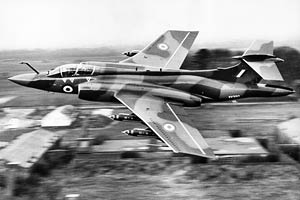
S.2B XV350 carrying 4 Martels over Holme-on-Spalding-Moor, 1971
Buccaneers hung on in the navy longer than expected, being upgraded to S.2C standard (similar to the S.2A) and some to S.2D standard (similar to the S.2B). Use in the overland role with the RAF, particularly the RAF Germany squadrons, meant improvements in the Buccaneer's ECM fit were needed, and these trickled back to the navy examples too. Production of new Buccaneers for the RAF ceased in 1977, with 49 manufactured (a total of 90 being in use when the ex-RN examples were included). When HMS Ark Royal docked for the last time in 1978, her Buccaneers and Phantoms had been transferred to the RAF and 809 NAS disbanded. The government had retained some sense, thankfully, and a partial replacement for the carrier force was soon at hand in the shape of the new 'through-deck cruisers' (Harrier carriers).
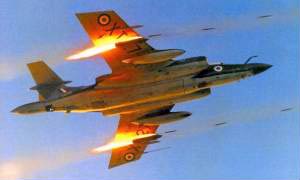
S.2B XT270 firing SNEB rocket pods; MoD
By now the RAF had realised what a stroke of luck gaining the Buccaneer had been, after all their previous hostility towards the aircraft. The unrivalled low-level stability of the Buccaneer meant that RAF Buccaneer squadrons consistently outperformed other low-level strike aircraft and did particularly well at the annual 'Red Flag' exercises in Nevada in the US. The legend goes that the Buccaneer can actually ride on its own shock wave at low level, and naturally stays at the height where the pressure from the wave counteracts any tendency to drop lower! 12 squadron had been the first RAF Buccaneer squadron to form (in October 1969), followed by 237 Operational Conversion Unit (OCU - for training new crews). 15 and 16 squadrons formed in October 1970 and January 1971, being the RAF Germany squadrons. The aircraft of 15 and 16 squadrons often had the refuelling probe removed as in-flight refuelling was not practiced in Germany. 208 squadron formed in July 1974 and finally 216 squadron formed in February 1979 marking the final transfer of all Buccaneer operations to the RAF.
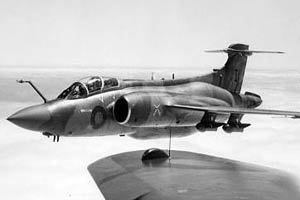
S.2B airborne from RAF Honington, 1983; Rick Kent's collection
The entire Buccaneer fleet was grounded in February 1980 after one Buccaneer broke up in mid-air during a Red Flag exercise killing the crew. Investigation found serious fatigue problems - a modification made in the S.2 variant had affected the ability of one of the spars to cope with stress and apart from 12 and 216 squadrons (anti-shipping squadrons which mostly flew over the sea and thus did much less of the overland hard manouevring) most Buccaneers were affected. No RAF Buccaneer would fly again until August, when only those Buccaneers not too badly affected were allowed to fly. The opportunity was taken to slim down the force slightly and 216 squadron was disbanded. New spar rings were gradually fitted to the fleet and operation with Laser Guided Bombs (LGBs) and the Pave Spike designation system began (LGBs finding favour after some use by RAF Harrier GR.3s in the successful Falklands campaign of 1982) but by 1983 Buccaneer operations were cut back - the Tornado had arrived. 15 squadron changed to Tornado operation in July, 16 squadron followed in February 1984. 208 squadron was re-tasked with the maritime role 216 had previously undertaken, and a programme to upgrade the maritime-tasked Buccaneers began - Martel was no longer an effective enough missile, and British Aerospace's Sea Eagle was the ideal replacement (having had a reprieve after the post-Falklands defence review decided that air-to-ship missiles were rather more effective than had been thought!).
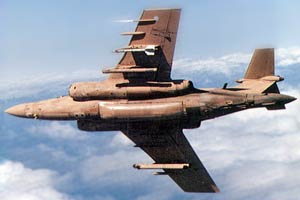
Operation Granby - unidentified S.2B; MoD
By 1986 the remaining Buccaneers had been given self-defence measures; some were upgraded to give Sidewinder missile capability and most could carry ALQ-101 ECM pods and had chaff and flare dispensers fitted. 208 squadron were now fully Sea Eagle capable though 12 squadron were not. 237 OCU gained a new tasking for wartime; that of designating the targets for LGB attacks by Jaguar and Tornado aircraft. The various upgrades to the Buccaneer fleet were all with the aim of keeping the aircraft in service until 1993 or 1995 at the very latest. The stage looked set for the Buccaneer to retire without ever having seen action with the RN or RAF. The South Africans, however, had been using their Buccaneers in anger for some time - first they were used to sink two wrecked oil tankers off the Cape and then they were called upon to attack targets in Angola during South Africa's involvement in the Angolan border war. First missions being flown in early May 1978, the war dragged on for another ten years or so. South African Buccaneers were flown with stunning bravery and were soon accorded great respect by the Angolans, who never managed to down any of the tough old jets. Action for the RAF's Buccaneers would wait for a few more years - when Saddam Hussein woke up one morning in 1990 and decided that invading Kuwait would be more fun than gassing his own population, Buccaneers were not among the RAF aircraft initially deployed to the Gulf. However, they were suddenly called upon on January 23rd 1991 to provide laser designation for the Tornado squadrons. Within 3 days the teams at RAF Lossiemouth had prepared six aircraft (newly painted desert pink, fitted with new secure radios, old-style S.1 wingtips for a smoother ride over the flat desert floor and more up-to-date chaff and flare dispensers) and sent them to Saudi Arabia. Six others followed and the first mission was carried out on the 2nd of February. In 216 sorties, the elderly Buccaneers designated targets for 169 Tornado-delivered LGBs and the Buccaneers also dropped 48 LGBs themselves, with no losses whatsoever.

Sky Pirates - Buccaneer nose art
Known as "Grandma's Finest Hour", the Gulf War had both proved the Buccaneer's excellence in the attack role (even though it was not the low-level role it had always performed until then) but it had also proved the excellence of another piece of kit - the TIALD laser designation system experimentally fitted to a few Tornados. With the Tornado also being converted to have Sea Eagle capability, the Buccaneer's days were numbered.
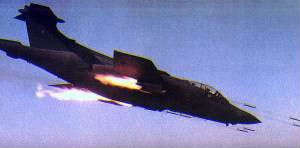
S.50 firing rocket pods in the final year of operation by the SAAF; the late Herman Potgieter
The South Africans retired their last few examples on 30 June 1991, and the RAF's 237 OCU disbanded in October 1991, its training task no longer necessary. 12 squadron disbanded in October 1993, 27 squadron replacing it (with Tornados). With problems with the maritime attack Tornado - the GR.1B - 208 squadron soldiered on. A new 12 squadron was formed in January 1994 with Tornado GR.1Bs at Lossiemouth and began their working-up period. In the last weeks of service, some of 208's Buccaneers were painted in colour schemes reflecting the use of the Buccaneer by both the RN and RAF over the years, but it all ended in March 1994 as the new 12 squadron became fully operational. It is a tribute to the Buccaneer's designers that not only does the Tornado replacement not have the range of the Buccaneer, it could not carry as many Sea Eagle missiles!
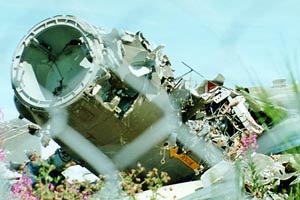
How it all ends - Buccaneer nose at scrapyard in Elgin near Lossiemouth, 10th August 1997; author
This was not quite the end of Buccaneers flying in the UK - three aircraft used for research and development work were still flying, and continued to do so until October 1994 when a final flypast was made by all three over HMS Ark Royal. The total production run had been 211 examples. At the time of writing, no more than 40 still exist with the remainder having been lost in accidents or, for the most part, scrapped.
And those final three flyers? Well if you want to see any of them fly, you'd better go to South Africa - where they have joined Mike Beachyhead's collection of airworthy classic jets. One did fly in civil hands in the UK in 2002 before departing for South Africa, but Buccaneer action in the UK has been limited to the trio of taxiable examples at Bruntingthorpe. Hawker Hunter Aviation at Scampton do have a Buccaneer as part of their fleet, which they had hoped to return to the air for trials and defence simulation work, but to date no suitable contract has materialised.
Leading Particulars
| Variant | NA.39 | S.1 | S.2 | S.2A | S.2B | S.2C | S.2D | S.50 | |
|---|---|---|---|---|---|---|---|---|---|
| First flight | 30 Apr 1958 | 23 Jan 1962 | 17 May 1963 | 11 Feb 1969 | 8 Jan 1970 | ? | Nov 1967 | Jan 1965 | |
| Crew | Two - pilot and observer/navigator | ||||||||
| Armament | None | Eight 1,000 lb bombs, WE177 tactical nuclear weapon, rocket pods | As S.1 plus an additional four 1,000 lb bombs | As S.2 plus three Martel ARMs, two Bullpup AGMs, four Sea Eagle ASMs, 1,000 lb LGBs, Sidewinder AAM | As S.2 plus four AS.30 AGMs | ||||
| Powerplant | ? | Two 7,100 lb de Havilland Gyron Junior turbojets | Two 11,100 lb Rolls Royce Spey RB168-1A Mk 101 turbojets | As S.2 plus 8,000 lb BS.605 rockets | |||||
| Max. speed | ? | ? | 562 knots (mach 0.85) at sea level, 600 knots at altitude | ||||||
| Service ceiling | ? | 40,000 ft | Not published but 40,000 ft plus | ||||||
| Range | ? | ? | 2,300 miles on a hi-lo-hi attack mission with slipper tanks | ||||||
| Empty weight | ? | 30,000 lb | |||||||
| Max. take off weight | ? | ? | 62,000 lb | ||||||
| Wing span | ? | ? | 44 ft | ||||||
| Wing area | ? | 514.7 sq ft | |||||||
| Length | ? | 63 ft 5 in | |||||||
| Height | ? | 16 ft 3 in | 16 ft 6 in | ||||||
